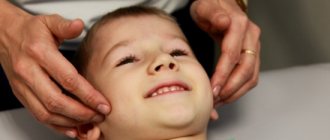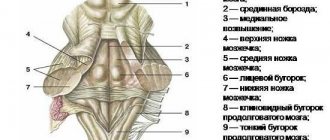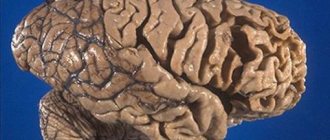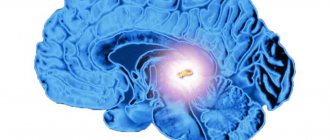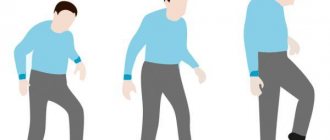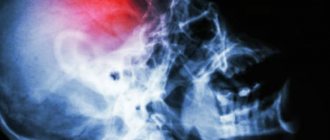Dysarthria is a speech disorder that develops as a result of organic damage to the areas of the brain that are the speech-motor analyzer, as well as due to damage to the nerve endings responsible for the innervation of the muscles of the articulatory apparatus. It is difficult for people without appropriate education to understand what dysarthria is, since it is not a single disease with severe symptoms, but a series of disorders. Moreover, each age category of children has its own characteristics of this speech disorder.
A distinctive symptom of dysarthria is that the problem does not arise with the pronunciation of certain sounds, but the entire pronunciation part of speech suffers. In this case, there is a limitation in the mobility of not only speech, but also facial muscles. The child’s speech is not smooth, it is unclear and blurred, its pace can be accelerated or slowed down. The voice also suffers, which can be harsh, or, conversely, quiet, dull and weak.
The severity and severity of this condition largely depends on the nature of the existing damage. Despite the fact that dysarthria, as a speech disorder, has been known since ancient times, even the currently existing treatment methods do not always make it possible to completely correct this disorder. Recovery options depend on many factors.
Successful correction of dysarthria requires an integrated approach consisting of speech therapy sessions, drug treatment, physical therapy and physiotherapy.
Understand the problem
Nowadays, dysarthria is diagnosed in approximately 6% of children. This is a fairly high indicator to classify the disorder as common.
Despite the fact that the disease is quite common, many parents are confused when hearing the diagnosis of “dysarthria” in their child. Due to ignorance, treatment of a child’s pathology may be started late or follow the wrong plan. For children, it is important to do everything on time, including correcting pronunciation, otherwise the incorrect pronunciation model can be firmly fixed and remain forever.
With dysarthria, organic damage occurs to the facial muscles involved in the formation of speech: the muscles of the cheeks, tongue, and the area around the mouth. Nerve fibers innervating muscles and skin are also affected. As a result, facial expressions become impoverished. Dysarthric is deprived of the opportunity to fully work the facial muscles in order to pronounce the desired sound. The baby's speech becomes unintelligible, quiet, and monotonous.
Among the causes of the disorder are:
- severe toxicosis of pregnant women;
- Rhesus conflict;
- intrauterine infection;
- prematurity;
- premature birth;
- intrauterine fetal hypoxia;
- asphyxia of newborns;
- birth injuries;
- hereditary diseases;
- traumatic brain injury;
- hydrocephalus;
- infectious brain damage;
- intoxication of various origins;
- purulent otitis.
Dysarthria often accompanies cerebral palsy and mental retardation.
recognize their child’s illness at the beginning of their journey by the following signs:
- weakness of the facial muscles, accompanied by prolapse of the tongue, half-open mouth;
- spasm of the facial muscles - the child closes his lips tightly;
- late appearance of speech;
- problems with eating food – constant choking, difficulty swallowing, holding food in the cheek for a long time;
- increased salivation recorded after 6 months;
- the baby talks “in his nose” for no reason;
- speech without emotional coloring, too fast or slow. In case of increased tone of the vocal cords, the voice is squeaky;
- distortion, omission of individual sounds;
- impaired fine motor skills - difficulty fastening buttons or tying shoelaces. Cannot sculpt from plasticine, cannot draw due to weakness of holding a pencil;
- poor ear for music;
- speech breathing is impaired. Children, pronouncing a phrase, gasp, pause in pronunciation;
- complete muteness is possible due to paralysis of the facial muscles.
At 5 years old, the articulation of all sounds should be formed. If this does not happen, then the existing tongue-tiedness cannot be attributed to age. Specialist intervention is required. The sooner children go to a speech therapist, the better for them and their parents.
Often the problem is diagnosed as a rib at the age of about 7 years, before entering school. This age is considered late for the start of correction; the work will be more difficult and more effort will be required.
Characteristics of bulbar dysarthria
Bulbar dysarthria is a pathology that appears when speech function is impaired due to damage to the nerves located in the muscle tissues of the pharynx and larynx. As a result of disruption of the connection between the muscles of the speech organs and the central nervous system, the functioning of:
- larynx;
- pharynx;
- palate;
- language;
- lips
The characteristics of the disease are as follows: bulbar dysarthria is manifested by the loss of the ability to pronounce voiced sounds, the sound acquires a neutral tone, and labial sounds are distorted. The patient's voice strength decreases, speech becomes unclear and incomprehensible.
When the soft palate sag, a nasal pronunciation is noted, since when exhaling, the air flow moves freely through the nose. And with atrophy of the pharyngeal muscles, problems with swallowing food arise.
Both adults and children of any age category can encounter pathology. But in childhood the disease is more unfavorable. A sick child cannot write at a sufficient speed, reads poorly, and has impaired diction.
Where to start treatment
Treatment of any disease must begin with a correct diagnosis. A young patient is first referred to a neurologist for consultation. After the examination, the specialist, if necessary, prescribes examinations :
- EEG;
- electromyography;
- MRI;
- electroneurography;
- transchannel magnetic stimulation.
After the diagnosis is established, the child is sent to a speech therapist who conducts special speech therapy tests. They allow you to determine the degree of the disease and its form. Subsequently, a neuropsychiatrist and a defectologist are involved in the process.
There are four degrees of the disease :
- 1st degree – the diagnosis is established only through special tests by a competent specialist;
- 2nd degree – speech is understandable, but has minor defects;
- 3rd degree – only close relatives understand the speech;
- 4th degree – speech is incomprehensible or absent.
Depending on the degree of the disorder, the specialist prescribes treatment and carries out corrective measures.
Sequence of treatment measures
If you believe that the treatment of dysarthria comes down to visits to a speech therapist, where the dysarthric person is taught to form a tube with his lips, then your opinion is wrong. There is a certain sequence of events, which is not recommended to be violated.
Elimination of dysarthria begins with restoration of the speech-motor system. To do this, the baby is given a speech therapy massage to develop fine motor skills. Breathing exercises are also used.
Speech therapy massage is one of the most effective methods of restoring the functioning of the speech apparatus. Massage affects the muscles, allowing them to normalize their tone. Therefore, the specialist first determines its level: hypo- or hypertonicity.
Speech therapy massage is divided into several types:
- manual;
- mechanical;
- hardware.
The manual technique is based on the impact of fingers on certain areas of the cheeks, lips, and tongue. The specialist carries out stroking and slight kneading of the muscle frame of the lips, cheeks and chin. Connects lips with fingers in vertical and horizontal positions. Massages the soft palate.
Mechanical technique involves influencing problem areas using special probes.
The hardware method uses vacuum, vibration, and temperature devices. It allows you to restore the nerve pathways connecting muscles with centers in the brain.
Dysarthric children are able to independently massage at home. simple exercises for this :
- baring teeth;
- lip stretching;
- open - close your mouth;
- the child puts a candy on a stick in his mouth, the adult takes it out. The smaller the volume of candy, the more difficult it is to do the exercise.
Massage allows you to:
- restore normal muscle tone;
- eliminate pathological movements of speech muscles;
- increase the amplitude of articulatory actions;
- makes muscles work that were not previously involved in the process;
- coordinates the movement of speech organs.
Breathing exercises
Speech
breathing is a complex process consisting of a strict relationship between the respiratory act and articulation. In small dysarthrics, such coordination is impaired. Before pronouncing the phrase, children take insufficient breath. They are able to speak while inhaling or at the very end of exhaling. Non-speech breathing is characterized by superficiality and rhythm instability.
Correct speech breathing ensures smoothness and softness of speech. With dysarthria, it is very important to improve this aspect of the process. Breathing exercises were developed for this purpose.
The most effective is breathing exercises according to A.N. Strelnikova . This is a set of original exercises that have no analogues in the world. The exercises focus on inhalation. It should be sharp, short, and delivered through the nose. When exhaling, attention is minimal. It is carried out arbitrarily.
There are main rules for performing exercises , if followed, the effect will be noticeable very quickly:
- The child takes a sharp, emotional, active breath through his nose. An analogy is drawn with the feeling of burning. At the same time, you can repeat: “Anxiety, it smells like burning,” and inhale the air, as if sniffing. Attention is concentrated on inhalation.
- Exhalation is done through the mouth. We explain to the baby that there is no need to hold back the air coming out. Let it come out spontaneously, without control.
- Inhale should be done as if inflating a car tire. Frequency – 60-70 breaths/minute. Pause – up to 3 seconds. In one lesson you need to perform 1000-2000 repetitions.
- The exercise should be done easily, without tension, without leading to a state of lack of air. Everything is within accessible limits.
The lesson begins with a warm-up, and only then can you move on to the main part.
Examples of exercises:
- half squat We bring one leg forward, the other behind. We squat shallowly, leaning on the front leg. While squatting, we take a short, rhythmic breath;
- holding your breath. We take a short breath while leaning forward. We hold our breath while counting to eight. We gradually increase the quantity.
Speech therapy exercises for erased dysarthria
Office of psychological and pedagogical correction of Lebyazhinsky district
Design of materials for information stands:
Speech therapy exercises for erased dysarthria.
Prepared by speech therapist teacher: Mukhambetova F.B.
Akku village 2021, December
According to research by R.I. Martynova, children with a mild form of dysarthria lag behind in physical development significantly more than children with functional dyslalia. In children with an erased form of dysarthria in the speech system, neurological symptoms were identified: erased paresis, hyperkinesis, disorders of muscle tone in the articulatory and facial muscles. Neuropsychiatric disorders were significantly more detected in mild forms of dysarthria than in functional dyslalia. That. The work of a speech therapist with children with an erased form of dysarthria should not be limited to the production and correction of defective sounds, but should have a wider range of correction of the child’s speech as a whole.
The peculiarities of the content of speech therapy work with an erased form of dysarthria are reflected in the specifics of planning correctional work: an additional preparatory stage is introduced, which is necessary to normalize motor skills and the tone of the articulatory apparatus, and the development of prosody.
Having studied the methods of L.V. Lopatina, N.V. Serebryakova, L.A. Danilova, I.I. Ermakova, E.M. Mastyukova, E.F. Arkhipova, I selected and systematized practical material for all sections of the preparatory stage, taking into account the speech and non-speech symptoms of dysarthria.
1) Normalization of muscle tone of the articulatory apparatus - differentiated speech therapy massage (method by E.F. Arkhipova)
For children with hypertonicity and hyperkinesis, a relaxing massage is recommended. In such children, the face is frozen, the muscles are stiff, the muscles of the lips are stretched and pressed against the gums, the tongue is thick and shapeless, the tip of the tongue is not pronounced. Massage techniques: patting, tapping, light vibration, stroking for no more than 1.5 minutes. All movements go from the periphery to the center: from the temples to the center of the forehead, nose, middle of the lips.
For children with hypotension - a strengthening massage. In such children, the facial muscles are flabby and loose, the mouth is open, the lips are flaccid, the thin tongue lies at the bottom of the mouth. Techniques: deep rubbing, kneading, stroking with force for up to 3 minutes. All movements are from the center of the face to the sides: from the forehead to the temples, from the nose to the ears, from the middle of the lips to the corners, from the middle of the tongue to the tip.
2) Normalization of motor skills of the articulatory apparatus:
exercises for masticatory muscles (met. I.I. Ermakova)
- Open your mouth and close it.
- Move the lower jaw forward.
- Open your mouth and close it.
- Puff out your cheeks and relax.
- Open your mouth and close it.
- Lateral movements of the lower jaw.
- Open your mouth and close it.
- Pull your cheeks in and relax.
- Open your mouth and close it.
- Bite your upper lip with your lower teeth
- Open your mouth with your head thrown back, close your mouth with your head straight.
gymnastics for voluntary tension and movement of lips and cheeks (met. E.F. Arkhipova)
- Inflating both cheeks at the same time.
- Puffing out the cheeks alternately.
- Retraction of the cheeks into the oral cavity.
- The closed lips are pulled forward with a tube (proboscis) and then returned to their normal position.
- Grin: the lips are stretched to the sides, pressed tightly against the gums, both rows of teeth are exposed.
- Alternating grin-proboscis (smile-pipe).
- Retraction of the lips into the oral cavity with the jaws open.
- Lifting only the upper lip, exposing only the upper teeth.
- Retraction of the lower lip, exposing only the lower teeth.
- Alternately raising and lowering the upper and lower lips.
- Imitation of rinsing teeth.
- Lower lip under upper teeth.
- Upper lip under lower teeth.
- Alternating the two previous exercises.
- Lip vibration (horse snorting).
- As you exhale, hold the pencil with your lips.
passive gymnastics for the muscles of the tongue - creating positive kinesthesia in the muscles (met. O.V. Pravdina)
Passive gymnastics is a form of gymnastics when a child makes movements only with the help of mechanical action - under the pressure of an adult's hand. . Passive movement should be carried out in 3 stages: 1 - entering the position (pucker your lips), 2 - maintain the position, 3 - exiting the position. After several repetitions, an attempt is made to perform the same movement one or two more times without mechanical assistance, i.e. passive movement is translated first into passive-active, and then into voluntary, performed according to verbal instructions.
An approximate complex of passive gymnastics:
- The lips close passively and are held in this position. The child's attention is fixed on closed lips, then he is asked to blow through his lips, breaking their contact;
- Using the index finger of the left hand, lift the child’s upper lip, exposing the upper teeth; with the index finger of the right hand, raise the lower lip to the level of the upper incisors and ask the child to blow;
- The tongue is placed and held between the teeth;
- The tip of the tongue is pressed and held against the alveolar process, the child is asked to blow, breaking the contact;
- The child's head is thrown back somewhat, the back of the tongue is raised towards the hard palate, the child is asked to make coughing movements, fixing his attention on the sensations of the tongue and palate.
active articulatory gymnastics - improving the quality, accuracy, rhythm and duration of articulatory movements; An important section of articulatory gymnastics for dysarthrics is the development of more subtle and differentiated movements of the tongue, activation of its tip, delimitation of movements of the tongue and lower jaw.
An approximate set of static articulation exercises for dysarthrics. L.V. Lopatina, N.V. Serebryakova
- Open your mouth, hold it open while counting from 1 to 5-7, close it.
- Open your mouth slightly, push your lower jaw forward, hold it in this position for 5-7 seconds, return to its original position.
- Pull the lower lip down, hold it while counting from 1 to 5-7, return to its original state; - raise your upper lip, hold it while counting from 1 to 5-7, return to its original state.
- - stretch your lips into a smile, exposing the upper and lower incisors, hold the count from 1 to 5-7, return to their original state; - stretch only the right (left) corner in a smile, exposing the upper and lower incisors, hold it counting from 1 to 5-7, return to its original position.
- - raise the right one, then the left one in turn: the corner of the lip, while keeping the lips closed, hold the count from 1 to 5-7, return to its original state.
- - stick out the tip of your tongue, mash it with your lips, pronouncing the syllables pa-pa-pa-pa. After pronouncing the last syllable, he will leave his mouth slightly open, fixing his wide tongue and holding it in this position, counting from 1 to 5-7; - stick the tip of your tongue between your teeth, bite it with your teeth, pronouncing the syllables ta-ta-ta-ta. After pronouncing the last syllable, leave the mouth slightly open, fixing the wide tongue and holding it in this position, counting from 1 to 5-7, return to its original position.
- - place the tip of the tongue on the upper lip, fix this position and hold it counting from 1 to 5-7, return to its original state; - place the tip of the tongue under the upper lip, fix it in this position, hold it while counting from 1 to 5-7, return it to its original state; - press the tip of the tongue to the upper incisors, hold the given position counting from 1 to 5-7, return to its original state; - the movement of “licking” with the tip of the tongue from the upper lip into the oral cavity behind the upper incisors.
- – give the tip of the tongue a “bridge” (“slide”) position: press the tip of the tongue against the lower incisors, raise the middle part of the back of the tongue, press the lateral edges to the upper lateral teeth, hold the specified position of the tongue counting from 1 to 5-7, lower the tongue .
An approximate set of dynamic articulation exercises for dysarthrics. L.V. Lopatina, N.V. Serebryakova
- Stretch your lips into a smile, exposing the upper and lower incisors; Pull your lips forward like a tube.
- Stretch your lips into a smile with your incisors bared, and then stick out your tongue.
- Stretch your lips into a smile with your incisors bared, stick out your tongue, press it with your teeth.
- Raise the tip of your tongue onto your upper lip and lower it onto your lower lip (repeat this movement several times).
- Place the tip of your tongue under the upper lip, then under the lower lip (repeat this movement several times)
- Press the tip of your tongue behind the upper, then lower incisors (repeat this movement several times).
- Alternately make the tongue wide, then narrow.
- Lift your tongue up, place it between your teeth, and pull it back.
- Build a “bridge” (the tip of the tongue is pressed against the lower incisors, the front part of the back of the tongue is lowered, the front part is raised, forming a gap with the hard palate, the back part is lowered, the lateral edges of the tongue are raised and pressed against the upper lateral teeth), break it, then build it again and again break, etc.
- Alternately touch the protruding tip of your tongue to the right, then to the left corner of your lips.
- Raise the tip of your tongue to the upper lip, lower it to the lower lip, alternately touch the protruding tip of the tongue to the right, then to the left corner of the lips (repeat this movement several times).
3) Development of fine motor skills of the hands:
- massage and self-massage of fingers and hands;
- games with small objects: stringing beads, mosaics, small construction sets;
- finger gymnastics complexes;
- developing self-service skills: buttoning and unbuttoning buttons, tying shoes, using a fork and knife;
- classes with plasticine and scissors;
- preparing your hand for writing: coloring and shading pictures, tracing stencils, graphic dictations, working with copybooks;
A set of exercises for self-massage of hands and fingers.
1. Children use the pads of four fingers, which are placed at the base of the fingers on the back of the hand being massaged, and dotted movements back and forth, shifting the skin by about 1 cm, gradually moving them towards the wrist joint (“dotted” movement).
Iron
We'll smooth out the wrinkles with an iron, everything will be fine. Let's iron all the pants of the hare, hedgehog and bear.
2. Using the edge of their palm, children imitate “sawing” in all directions on the back of the hand (“straightforward” movement). The hand and forearm are placed on the table, the children are sitting.
Saw
Drank, drank, drank, drank! Cold winter has come. Let's get some wood for us quickly, let's light the stove and warm everyone up!
3. Rotational movements are made with the base of the hand towards the little finger.
Dough
We knead the dough, we knead the dough, We will bake pies with cabbage and mushrooms. — Should I treat you to some pies?
4. Self-massage of the hand from the palm side. The hand and forearm are placed on the table or on the knee, the children are sitting. Stroking.
Mother
Mom strokes her little son on the head, Her palm is so tender, Like a willow twig. - Grow up, dear son, Be kind, brave, honest, Gain intelligence and strength. And don't forget me!
5. Move the knuckles of your fingers clenched into a fist up and down and from right to left along the palm of the hand being massaged (“straight-line movement”).
Grater
Together we help mom, grate beets with a grater, together with mom we cook cabbage soup, - Look for something tastier!
6. The phalanges of the fingers clenched into a fist make a movement according to the “gimlet” principle in the palm of the massaged hand.
Drill
Dad takes the drill in his hands, And it buzzes, sings, As if a fidgety mouse is gnawing a hole in the wall!
7. Self-massage of fingers. The hand and forearm of the arm being massaged are located on the table, the children are sitting. With “pincers” formed by the bent index and middle fingers, a grasping movement is made for each word of the poetic text in the direction from the nail phalanges to the base of the fingers (“rectilinear” movement).
Ticks
The pliers grabbed the nail and tried to pull it out. Maybe something will work out if they try!
8. The pad of the thumb, placed on the back side of the massaged phalanx, moves, the other four cover and support the finger from below (“spiral” movement).
Lambs
“Byashki”, curly-haired lambs, graze in the meadows. All day long it’s all: “Be and be,” They wear fur coats on themselves. Fur coats in curls, look, “Byashki” slept in curlers, In the morning they took off the curlers, Try to find a smooth one. Everyone is curly-haired, every single one, They run in a curly-haired crowd. This is their fashion, the sheep people.
9. Movements as when rubbing frozen hands.
Morozko
Morozko froze us, crawled under a warm collar, like a thief, carefully penetrated into our felt boots. He has his own worries - Know the frost, but get stronger! Don’t spoil, Frost, why don’t you treat people like that?!
4) Development of general motor skills and motor coordination:
- pantomime (book “Tell Poems with Your Hands”, “Psychogymnastics” by M.I. Chistyakov, “Movement and Speech” by I.S. Lopukhin);
- outdoor games for coordination and coordination of movements;
- special complexes of physical and rhythmic exercises (journal “Defectology” No. 4, 1999)
5) Normalization of voice and speech breathing:
— Breathing exercises by A.N. Strelnikova.
— Exercises for the development of speech breathing
The following exercises are recommended in speech therapy practice:
- Choose a comfortable position (lying, sitting, standing), place one hand on your stomach, the other on the side of your lower chest. Take a deep breath through your nose (this pushes your stomach forward and expands your lower chest, which is controlled by both hands). After inhaling, immediately exhale freely and smoothly (the abdomen and lower chest return to their previous position).
— Take a short, calm breath in through your nose, hold the air in your lungs for 2-3 seconds, then exhale long, smoothly through your mouth.
— Take a short breath with your mouth open and, with a smooth, drawn-out exhalation, pronounce one of the vowel sounds (a, o, u, i, e, s).
- Smoothly pronounce several sounds on one exhalation: aaaaa aaaaaooooooo aaaaaauuuuuu
- Count on one exhalation up to 3-5 (one, two, three...), trying to gradually increase the count to 10-15. Make sure you exhale smoothly. Count down (ten, nine, eight...).
- Read proverbs, sayings, tongue twisters in one breath. Be sure to follow the instructions given in the first exercise.
Practiced skills can and should be consolidated and fully applied in practice.
The tasks become more complex gradually: first, long speech exhalation training is carried out on individual sounds, then on words, then on a short phrase, when reading poetry, etc.
In each exercise, children’s attention is directed to a calm, relaxed exhalation, to the duration and volume of the sounds pronounced.
“Skits without words” help normalize speech breathing and improve articulation in the initial period. At this time, the speech therapist shows the children an example of calm expressive speech, so at first he speaks more during classes. “Skits without words” contain elements of pantomime, and speech material is specially kept to a minimum in order to provide the basics of speech technique and eliminate incorrect speech. During these “performances” only interjections are used (Ah! Ah! Oh! etc.), onomatopoeia, individual words (names of people, names of animals), and later short sentences. Gradually, the speech material becomes more complex: short or long (but rhythmic) phrases appear as speech begins to improve. The attention of beginning artists is constantly drawn to what intonation should be used to pronounce the corresponding words, interjections, what gestures and facial expressions to use. During the work, children’s own imaginations are encouraged, their ability to choose new gestures, intonation, etc.
Also, for the development of proper speech breathing, the following are recommended:
- special exercise games: playing pipes, blowing away small objects, blowing soap bubbles, etc.
- phonetic rhythm by Mukhina A.Ya.;
- voice exercises by Ermakova I.I., Lopatina L.V.
6) Formation of the prosodic side of speech according to met. Lopatina L.V.:
- exercises to develop rhythm (perception and reproduction of rhythm);
- exercises to master the rhythm of words;
- familiarity with narrative, interrogative, exclamatory intonation;
- formation of intonation expressiveness in expressive speech
7) Overcoming sensory impairments:
- development of spatio-temporal concepts in met. Danilova L.A.
- exercises to develop the sense of touch in met. Danilova L.A.
System of classes for preschool children (from 5 to 7 years old)
Development of spatial concepts.
- Determination of basic spatial (prepositional) relations on specific objects. The child, according to the instructions, rearranges the objects in the indicated directions.
- The name of the main spatial relationships in the plot picture.
- Development of constructive praxis.
- Development of spatial relationships in a child’s visual activity.
- Memory training for spatial relationships. Analysis of a picture from memory, taking into account the spatial relationships between objects. A story from memory about the location of objects in space... Training of trace tests of constructive praxis.
Office for the Development of Touch.
- Training to determine the texture of an object. Recognition of texture by touch during preliminary display.
- Determination of the texture and shape of real objects without prior demonstration.
- Differentiation by touch of different geometric bodies: a) the same shape, but different thicknesses (flat and volumetric); b) the same shape and thickness, but different sizes (large and small); c) the same size and thickness, but different shapes... The development of this ability is formed in stages:
- Stage I - recognition of three-dimensional figures by touch after preliminary visual familiarization with the figure;
- // stage - recognition of three-dimensional figures of the same texture without preliminary display;
- Stage III - recognition of flat figures of the same texture after visual familiarization;
- Stage IV - recognition of flat figures by touch without display;
- Stage V - recognition of figures by touch of the same shape, but different in texture after their preliminary examination;
- Stage VI - recognition of the shape and texture of an object by touch without prior inspection;
- Stage VII - distinguishing objects of the same shape and texture by size by touch...
 Development of temporal representations.
Development of temporal representations.
- Determination of the sequence of seasons, clarification in pictures and in verbal descriptions of the distinctive features of each season.
- Sequence of periods of the day, analysis of regime moments.
- Practicing the concepts of “older - younger”.
To form generalizations, exercises are carried out to develop generalizations by the method of elimination (the game “The Fourth Extra”).
- / stage - 4 objects are laid out in front of the child, united by certain properties.
- // stage - eliminating unnecessary objects in the picture.
To develop an understanding of cause-and-effect relationships
a guessing game is used... During the game, independent observations and certain concepts about objects are formed, cause-and-effect relationships are revealed.
As many years of observations have shown, the proposed correction methods can significantly develop unformed functions and prepare the child to perceive
9) Development of phonemic hearing according to met. T.A. Tkachenko, L.V. Lopatina, N.V. Serebryakova
Speech therapy work for erased forms of dysarthria at the preparatory stage ensures the effectiveness of correction at all subsequent stages of correctional work.
Development of fine motor skills
It would seem, what is the connection between correct speech and finger movement? It turns out that the center of speech and finger motor skills are located nearby in the brain, stimulating each other’s work. The better developed fine motor skills, the better and faster the development of speech.
Digging a little from the topic, I would like to simultaneously explain to parents that movement in general helps strengthen neural connections that allow you to remember new information. A sedentary child is difficult to teach.
Developing motor activity of the fingers allows you to enrich your vocabulary and improve the phonemic aspect of speech. There are many options for developing fine motor skills: modeling from plasticine; working with paper (sheets can be crumpled, torn, pieces plucked off, folded in a certain sequence); designing crafts, creating applications, collages will also develop creative thinking.
Specialists use finger gymnastics, special attributes to stimulate motor activity of the finger in:
- Pinch your earlobe between your thumb and index finger. Walk along the edge of the ear with massage movements;
- spread your fingers wide. Clap your palms until all fingers touch;
- bend your fingers. Using massaging movements, move from the ear to the crown;
- A child ties knots on a rope. Then he runs them over with his fingers;
- the use of various balls - corrugated, with spikes, stuffed with balls. Squeezing/unsqueezing them with your hands;
- use of expanders;
- clothespins, computer keyboards, phones with buttons.
There are many devices, specialized and household, that allow you to work on the development of fine motor skills. A specialist will tell parents about possible options and explain how to conduct classes independently at home.
Speech development exercise “My family”
Target:
to develop a child’s interest in speech and teach them to pronounce words by imitation.
Equipment:
two sets of knitted finger covers with images of family characters: dad, mom, son, daughter.
Content:
an adult puts a knitted fingertip on his finger and says: “Here’s dad. Hello, Misha. I am dad,” etc. After the fingertips are put on, the adult invites the child to show and name all family members in turn. The game is played several times.
Speech development exercise “Who lives in the house?”
Target:
to develop a child’s interest in speech and teach them to pronounce words by imitation.
Equipment:
toy houses, toys: mouse, frogs, cockerel.
Content:
an adult shows the houses, says that each one has an animal: “A frog lives in this house, it croaks - qua-qua; a mouse lives in this house, it squeaks - pee-pee;, a cockerel lives in this house, he screams - ku-ka-re-ku. Then the adult invites the child to knock on the house and ask who lives in the house: “Who lives there?” The adult says: “A frog lives there, it croaks,” invites the child to repeat - qua-qua, etc.
At the end of the game, the adult activates onomatopoeia in the child.
Pronunciation correction
After establishing the functioning of the articulatory apparatus and restoring muscle activity, the speech therapist proceeds to correcting incorrect pronunciation.
Typically, children exhibit the following pronunciation inaccuracies:
- omission of individual sounds, often “r”;
- replacing some sounds with others - “wak” instead of “rak”;
- interdental pronunciation, the so-called lisp;
- in isolation the sound is pronounced correctly. Problems appear when entering a word.
If such changes were noticed by parents, then speech therapy work should begin immediately, without waiting for 5 years.
Pronunciation correction requires an individual approach. The specialist determines which sounds are preserved and pronounced correctly. Work begins with sounds distorted to the least extent possible. Before performing them, it is necessary to teach children to distinguish them by ear.
The specialist’s task boils down to the following:
- modeling of basic articulation patterns - production of hissing, whistling, sonorant, palatal sounds;
- production of isolated sound;
- sound fixation, automatic inclusion in speech. First, for fixation, words are used in which the sound is present in an exaggerated form. Then any words with the desired sound symbol;
- pronunciation of a sound with an oppositional sound: sa-sha, sfa-tfa.
A speech therapist, in addition to the pronunciation aspect of speech, teaches the child lexical and grammatical basics, develops phrasal speech, and gives the basics of writing and reading skills.

